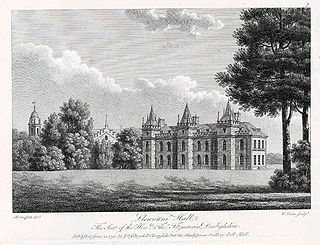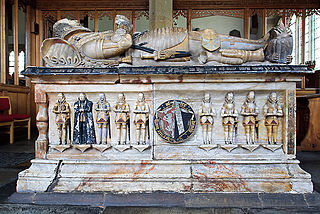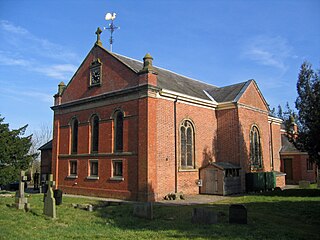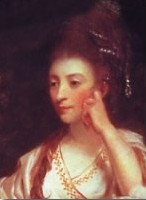
Hester Lynch Thrale Piozzi, a Welsh-born diarist, author and patron of the arts, is an important source on Samuel Johnson and 18th-century English life. She belonged to the prominent Salusbury family, Anglo-Welsh landowners, and married first a wealthy brewer, Henry Thrale, then a music teacher, Gabriel Mario Piozzi. Her Anecdotes of the Late Samuel Johnson (1786) and her diary Thraliana, published posthumously in 1942, are the main works for which she is remembered. She also wrote a popular history book and a dictionary. She has been seen as a protofeminist.

Henry Thrale was a British politician who sat in the House of Commons from 1765 to 1780. He was a close friend of Samuel Johnson. Like his father, he was the proprietor of the large London brewery H. Thrale & Co.
The Salusbury family is an Anglo-Welsh family notable for their social prominence, wealth, literary contributions and philanthropy.

Katheryn of Berain, sometimes called Mam Cymru, was a Welsh noblewoman noted for her four marriages and her extensive network of descendants and relations.
Sir John Salusbury Piozzi Salusbury was a British civil servant and, briefly, a military officer during the Battle of Waterloo. He was named after his adopted grandfather, Sir John Salusbury.

Lleweni Hall was a stately home in Denbighshire, northeast Wales, around 2 miles (3.2 km) north-east of Denbigh on the banks of the River Clwyd. It was the principal seat of the Salusbury family and their descendants from 1289 until 1748, and the present territorial designation of the most senior branch of the family.
Sir John Salusbury was a Welsh nobleman, explorer and co-founder of Halifax, Nova Scotia. He is credited as being one of the founders of modern Canada along with several other members of his expedition, including the Earl of Halifax and Edward Cornwallis. He served on the Nova Scotia Council throughout Father Le Loutre's War. He participated in the Battle at Chignecto. His diaries regarding the military campaign to establish a colony in Nova Scotia on behalf of the British Government became a vital source of information regarding the hardships, difficulties and opposition from the average Englishman regarding the development of the colony. He was a direct descendant of Katheryn of Berain.

Sir Robert Salusbury Cotton, 5th Baronet was an English politician who sat in the House of Commons from 1780 to 1796.

There have been two baronetcies created for members of the Salusbury family, the first in the Baronetage of England and the second in the Baronetage of Great Britain. Neither title has survived to the present day although the senior baronetcy is technically considered to be dormant.

St Mary's and St Michael's Church is in the village of Burleydam in the civil parish of Dodcott cum Wilkesley, Cheshire, England. The church is some 1.5 miles (2 km) to the southeast of Combermere Abbey. It is recorded in the National Heritage List for England as a designated Grade II listed building. It is an active Anglican parish church in the diocese of Chester, the archdeaconry of Macclesfield and the deanery of Nantwich. Its benefice is combined with those of St Michael, Baddiley, and St Margaret, Wrenbury.

The Thraliana was a diary kept by Hester Thrale and is part of the genre known as table talk. Although the work began as Thrale's diary focused on her experience with her family, it slowly changed focus to emphasise various anecdotes and stories about the life of Samuel Johnson. The work was used as a basis for Thrale's Anecdotes of the Late Samuel Johnson, but the Thraliana remained unpublished until 1942. The anecdotes contained within the work were popular with Thrale's contemporaries but seen as vulgar. Among 20th-century readers, the work was popular, and many literary critics believe that the work is a valuable contribution to the genre and for providing information about Johnson's and her own life.

Sir Thomas Salusbury, 2nd Baronet was a Welsh poet, politician and soldier, who supported King Charles I in English Civil War and was a colonel of a Royalist regiment.
The Anecdotes of the Late Samuel Johnson or the Anecdotes of the Late Samuel Johnson, LL.D. During the Last Twenty Years of His Life by Hester Thrale, also known as Hester Lynch Piozzi, was first published 26 March 1786. It was based on the various notes and anecdotes of Samuel Johnson that Thrale kept in her Thraliana. Thrale wrote the work in Italy while she lived there for three years after marrying Gabriel Piozzi.

Hester Maria Elphinstone, Viscountess Keith, born Hester Maria Thrale, was a British literary correspondent and intellectual. She was the eldest child of Hester Thrale, diarist, author and confidante of Samuel Johnson, and Henry Thrale, a wealthy brewer and patron of the arts. She became the second wife of George Elphinstone, 1st Viscount Keith.
George Henry Glasse (1761–1809) was a notable Oxford Greek and Latin scholar, domestic chaplain to the Duke of Cambridge.
Matthew Dobson (1732–1784) was an English physician and experimental physiologist. He is now remembered for his work on diabetes.

The Lady's Last Stake, originally entitled Piquet: or Virtue in Danger, is a painting by William Hogarth, c.1759. The work is a conversation piece, capturing the moment when the woman has to make a fateful decision: to be ruined financially, or morally. It was one of Hogarth's last works, commissioned by James Caulfeild, 4th Viscount Charlemont, who allowed Hogarth to select the subject and price.

Mariano Bovi was an Italian engraver, publisher and art dealer.
Marianne Francis (1790–1832) was an English evangelical, now known principally as a correspondent of Hester Piozzi and Sarah Wesley. She has been called an "evangelical bluestocking", and is recognised as a significant participant in debate about religious enthusiasm.












